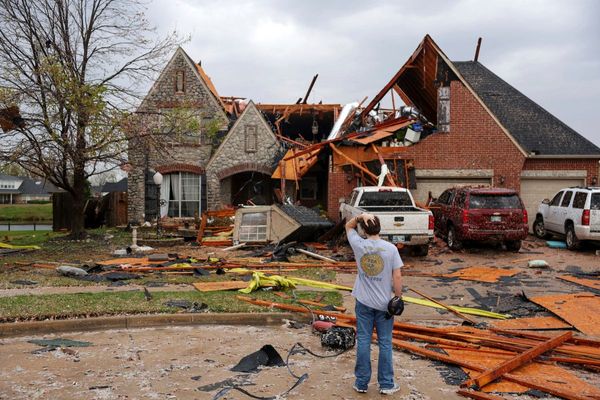
Mysterious blobs that lurk more than 1,000 miles underground may be remnants of a Mars-sized planet which slammed into Earth in the early solar system and produced a shower of debris that formed the moon, researchers say.
According to scientists’ leading theory, the moon was created about 4.5bn years ago when an ancient protoplanet named Theia thumped into the fledgling Earth. At the time, our home planet was still an infant and only about 85% of its size today.
The theoretical collision would have melted much of Earth and Theia, which reformed as a new, bulkier, Earth. Meanwhile, vast amounts of dust and rock were blasted into orbit where they came together to create the moon.
While many scientists find the giant impact scenario compelling, the search has continued for evidence to support the theory, not least any hallmarks of a violent collision that could still be found today.
With this in mind, an international team of researchers turned their attention to two continent-sized blobs buried deep inside Earth’s mantle, far beneath Africa and the Pacific Ocean. The blobs, known technically as large low-velocity provinces or LLVPs, were originally discovered by seismologists, but their origins have never been clear.
The researchers – including Dr Qian Yuan at the California Institute of Technology in Pasadena and Prof Hongping Deng at the Shanghai Astronomical Observatory, part of the Chinese Academy of Sciences – used computer simulations of the giant impact and convection currents inside Earth to explore how the cataclysmic event might have unfolded.
According to the simulations, the collision would have melted the upper half of the Earth’s mantle, allowing a hefty chunk of Theia, perhaps 10%, to penetrate further into the planet and gradually sink towards the core.

Over the next 4.5bn years, the rock from Theia could have moved around due to convection inside Earth and ultimately formed the blobs present today. The blobs, which are thought to be slightly denser than the surrounding mantle rock, are near the boundary with Earth’s core, about 1,800 miles down.
“To my knowledge, our work is the first one proposing this idea,” Yuan told the Guardian. Details are published in the journal Nature.
It may take a healthy supply of moon rocks for scientists to work out if the buried blobs are indeed remnants of an ancient Theia. Those rocks might be forthcoming in the years ahead as space agencies push on with their plans to establish a long-term presence on the moon in preparation for later trips to Mars.
“I look forward to seeing future missions on the moon to bring back its mantle rocks, which are very likely to come from the impactor Theia, according to the majority of moon-forming impact simulations,” Yuan said. “If the lunar mantle rock and LLVP-related basalts share the same chemical signatures, they should both originate from Theia.”
Prof Alex Halliday, who studies planetary evolution and materials at the University of Oxford and is a professor of earth and environmental sciences at Columbia University in New York, praised the paper but said there was more work to do on the idea – particularly around the processes that led to the varied makeup of the deep mantle while also achieving similar isotopic signatures between the Earth and the moon.
“This is a great paper with bold thinking and interesting conclusions,” he said. “However, it raises questions that need further discussion and analysis, particularly concerning the way the moon and Earth mixed to achieve so many similarities while preserving ancient deep-mantle heterogeneity.”
• This article was amended on 2 November 2023 to add further details of Prof Alex Halliday’s academic roles.







